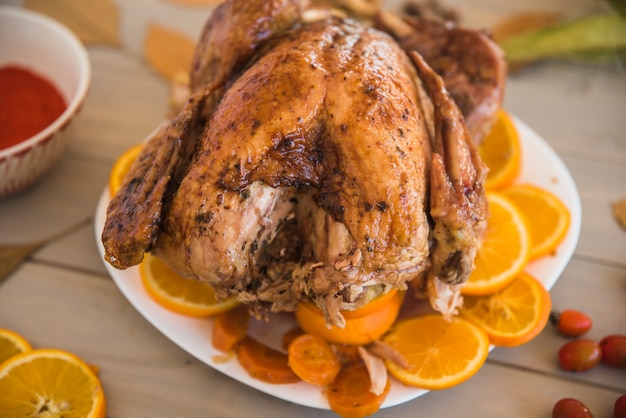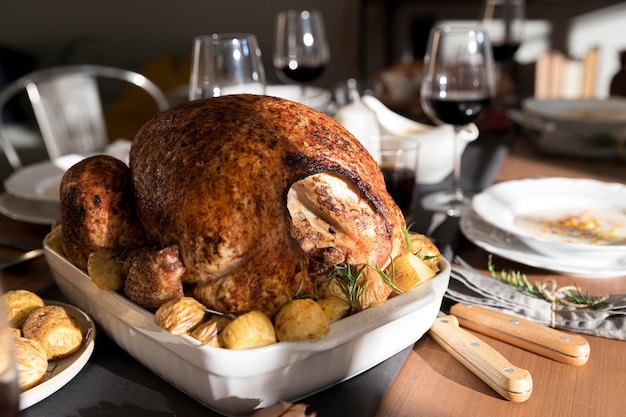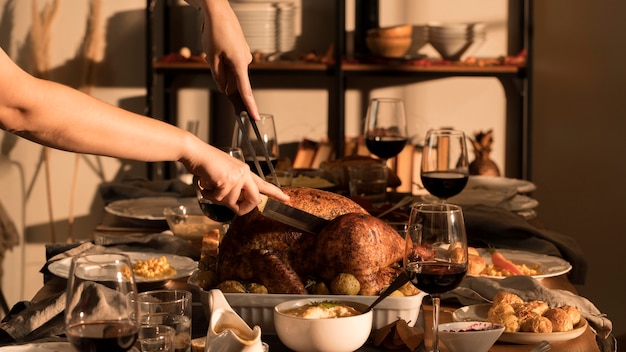As a seasoned home cook, I've had the pleasure (and occasional frustration) of tackling countless turkey roasts over the years. And let me tell you, there's a certain kind of magic that happens when you pull a perfectly roasted turkey out of the oven. The aroma that fills your home is enough to make you weak at the knees, and that crispy skin? Well, that's a culinary masterpiece in itself. But let's be real, getting that golden-brown exterior and juicy, flavorful meat requires a bit more than just throwing a bird in the oven and hoping for the best.
Today, I'm sharing all my secrets to mastering the art of roasting a turkey in your trusty roaster oven. We'll cover everything from selecting the right bird to ensuring it's cooked to perfection. So, grab your apron, get your oven preheated, and let's embark on this culinary journey together!
(Part 1) Choosing Your Turkey: Sizing Up the Situation

The first step is finding the perfect turkey for your feast. You want a bird that's big enough to feed everyone without leaving you with mountains of leftovers (unless you love leftovers, in which case, go wild!).
Turkey Sizes and cooking time: A Handy Guide
Here's a table that breaks down the most common turkey sizes and their estimated cooking times. Keep in mind that these are just guidelines – factors like oven temperature, turkey shape, and even how the bird was raised can all play a role in the final roasting time.
| turkey weight (kg) | Serving Size | Approximate Cooking Time (Hours) |
|---|---|---|
| 4-5 kg | 6-8 people | 3-4 hours |
| 5-6 kg | 8-10 people | 4-5 hours |
| 6-7 kg | 10-12 people | 5-6 hours |
| 7-8 kg | 12-14 people | 6-7 hours |
Fresh or Frozen? The Great Turkey Debate
Now, the million-dollar question: Fresh or frozen? This is a personal preference, and both options have their pros and cons. I personally lean towards fresh turkeys because I find the flavor to be a bit richer, but the convenience of frozen can't be denied.
If you opt for frozen, make sure you give it ample time to thaw in the refrigerator before roasting. A good rule of thumb is to allow one day of thawing for every 5 pounds of turkey.
(Part 2) Preparing Your Turkey: The Pre-Roast Ritual

Once you've chosen your turkey, it's time to get down to the business of prepping it for its starring role in your thanksgiving feast. These steps will help ensure a juicy, flavorful bird that everyone will rave about.
Pat It Dry: The Key to Crispy Skin
Start by patting your turkey dry with paper towels. This is essential for achieving that beautiful, crispy skin. Wet skin will steam in the oven, making it tough and soggy.
Brine It? A Matter of Preference
Brining is a popular technique that involves soaking the turkey in a salt water solution. Brining helps to keep the meat moist and flavorful, and it also tenderizes the breast. However, it's not for everyone. Some find that brining can make the meat a bit too bland.
If you decide to brine, a simple solution of salt, sugar, and water is all you need. You can also add herbs and spices to the brine for an extra flavour punch. Allow the turkey to brine for at least 12 hours, up to 24 hours.
Stuff It or Skip It? A Matter of Tradition and Safety
Stuffing is a traditional Thanksgiving dish, but I'm a big believer in cooking it separately for safety reasons. Cooking stuffing inside the bird can sometimes result in undercooked stuffing, which can be a food safety hazard.
If you do choose to stuff your turkey, make sure you cook it to an internal temperature of 165°F/74°C.
Season It Up: Let the Flavor Flow
Now for the fun part: seasoning! A simple mix of salt, pepper, and herbs is all you really need to create a delicious turkey. But don't be afraid to experiment. I love using a combination of rosemary, thyme, and sage – it complements the turkey's flavor beautifully.
Getting Ready to Roast: Setting the Stage
You'll need a roasting pan that's large enough to hold your turkey comfortably. And when it comes to turkey roasting, I'm a huge fan of roaster ovens. They distribute heat evenly, and cleanup is a breeze compared to a traditional oven.
If you're using a roaster oven, preheat it to the desired temperature (325°F/160°C) and place your turkey in the pan.
(Part 3) Roasting Time: The Heart of the Matter

Finally, it's time to get that turkey in the oven! This is the crucial stage where your patience and attention to detail will pay off.
The Turkey Roasting Time: A Guide to Timing
Here's the deal: you want to roast your turkey until the internal temperature reaches 165°F/74°C in the thickest part of the thigh. Use a meat thermometer to check the temperature. I recommend using a digital thermometer with a probe – it's much easier to keep an eye on the temperature without having to open the oven door constantly.
Here's a breakdown of general roasting times based on turkey size:
- Small turkey (4-5 kg): 3-4 hours
- Medium turkey (5-6 kg): 4-5 hours
- Large turkey (6-7 kg): 5-6 hours
- Extra-large turkey (7-8 kg): 6-7 hours
Don't Forget to Baste: Keeping It Moist and Flavorful
Basting is essential for maintaining a juicy, flavorful turkey. Every hour or so, baste the turkey with the pan drippings using a spoon or baster. This will help keep the skin crispy and the meat moist.
Resting Time: Letting the Juices Redistribute
Once your turkey reaches the desired temperature, take it out of the oven and let it rest for about 30 minutes before carving. This allows the juices to redistribute throughout the meat, resulting in a more tender and flavorful turkey.
(Part 4) Turkey roasting tips and Tricks: From Experienced Hands
Over the years, I've learned a few tricks that have helped me achieve consistently delicious turkeys. Here are some of my favorite tips:
Don't Overcrowd Your Roaster Oven
Make sure your turkey fits comfortably in the roasting pan. If the turkey is crowded, it won't cook evenly. Consider using a roasting rack to elevate the turkey and allow for better airflow.
Use a Roasting Rack: Elevate for Even Cooking
A roasting rack is a valuable tool for ensuring even cooking. It lifts the turkey off the bottom of the pan, allowing heat to circulate around the bird.
Keep an Eye on the Skin: Achieving that Golden-Brown Perfection
You want that beautiful golden-brown skin, but be careful not to let it burn. If the skin starts to brown too quickly, tent the turkey with foil to prevent it from burning.
Avoid Opening the Oven Door: Temperature Stability is Key
Every time you open the oven door, you lose heat, which can affect the cooking time and result in an unevenly cooked turkey. Only open the door to baste or check the temperature.
(Part 5) turkey leftovers: Putting Those Delicious Remains to Good Use
Leftovers are a culinary treasure. Don't waste them! There are so many delicious ways to use leftover turkey.
turkey sandwiches: A Classic comfort food
Turkey sandwiches are a classic leftover solution. You can keep it simple with mayonnaise, lettuce, and tomato, or get creative with different spreads like cranberry sauce or Dijon mustard.
turkey soup: Warming Up With Flavor
A hearty turkey soup is a perfect way to use up leftover turkey and vegetables. You can add noodles or rice to make it a more substantial meal.
turkey pot pie: A Comforting and Delicious Meal
A comforting pot pie is another great way to use leftover turkey. You can use a store-bought crust or make your own.
(Part 6) Turkey Roasting FAQs: Answering Your Questions
Here are some common questions that often come up when it comes to roasting a turkey.
1. How Do I Know if My Turkey is Done?
The most reliable way to tell if your turkey is done is to use a meat thermometer. Insert the thermometer into the thickest part of the thigh and make sure the internal temperature reaches 165°F/74°C.
2. What Should I Do If My Turkey is Overcooked?
Overcooked turkey will be dry. To help remedy this, you can add some moisture to the meat by adding broth or gravy to the pan and letting it simmer for a few minutes.
3. Can I Roast a Turkey in a Regular Oven?
Absolutely! Just make sure you use a large roasting pan and follow the same cooking instructions.
4. How Do I Store Leftover Turkey?
Store leftover turkey in the refrigerator for up to 4 days. You can also freeze leftover turkey for up to 3 months.
5. Can I Use frozen turkey for Roasting?
Yes, but it's crucial to thaw the turkey completely before cooking. You can thaw the turkey in the refrigerator for 24 hours for every 5 pounds of turkey, or you can thaw it in cold water for 30 minutes for every pound of turkey.
(Part 7) My Personal Roasting Experiences: Triumphs and Mishaps
Throughout my turkey roasting adventures, I've experienced both triumphs and mishaps.
One Christmas, I decided to try brining for the first time, thinking it would result in a perfectly juicy bird. Unfortunately, it turned into a disaster. The turkey was incredibly soggy, the skin was limp and greasy, and the meat was bland. It was a lesson learned!
Another time, I was roasting a turkey for a family gathering, and I got distracted by a phone call. I completely forgot about the bird, and it ended up being overcooked and dry.
But I've also had some amazing successes. My proudest moment was when I roasted a turkey for a friend's wedding. The turkey was perfectly cooked, the skin was crispy, and the meat was juicy and flavorful. Everyone raved about it!
My advice is to be patient, don't be afraid to experiment, and learn from your mistakes. You'll eventually find the rhythm and create a turkey that will make everyone happy.
(Part 8) The Joy of a Perfectly Roasted Turkey: A Culinary Triumph
There's a certain joy that comes with serving a perfectly roasted turkey. It's the centerpiece of a holiday feast, a symbol of togetherness and celebration. And when it's cooked to perfection, it's a truly delicious and satisfying experience.
So, go forth and roast a turkey! It may seem like a daunting task, but with a little practice and the right guidance, you'll create a masterpiece that will impress your friends and family.
And remember, the most important thing is to enjoy the process. Don't be afraid to experiment and have fun with it! After all, what's a holiday gathering without a delicious turkey?
Everyone is watching

Corn on the Cob: The Ultimate Guide to Perfectly Cooked Ears
Healthy MealsAh, corn on the cob. Just the name evokes images of sunny days, barbecues, and that sweet, juicy flavour that ...

Perfect Pork Roast Oven Cooking Time: A Guide to Delicious Results
Healthy MealsThere's something truly satisfying about a perfectly roasted pork. The aroma alone is enough to make your mout...

Ham Cooking Time: How Long to Bake, Smoke, or Boil a Delicious Ham
Healthy MealsAh, ham. It's a classic, isn't it? A real crowd-pleaser, especially around holidays. And when done right, it'...

Scallops: The Ultimate Guide to Perfect Cooking
Healthy MealsAh, scallops. Those delicate, sweet, and utterly delicious morsels of the sea. They hold a special place in my...

Spaghetti Squash: The Ultimate Guide to Cooking and Serving
Healthy MealsRemember that time you saw spaghetti squash at the supermarket, looking all bumpy and strange, and thought, "W...
